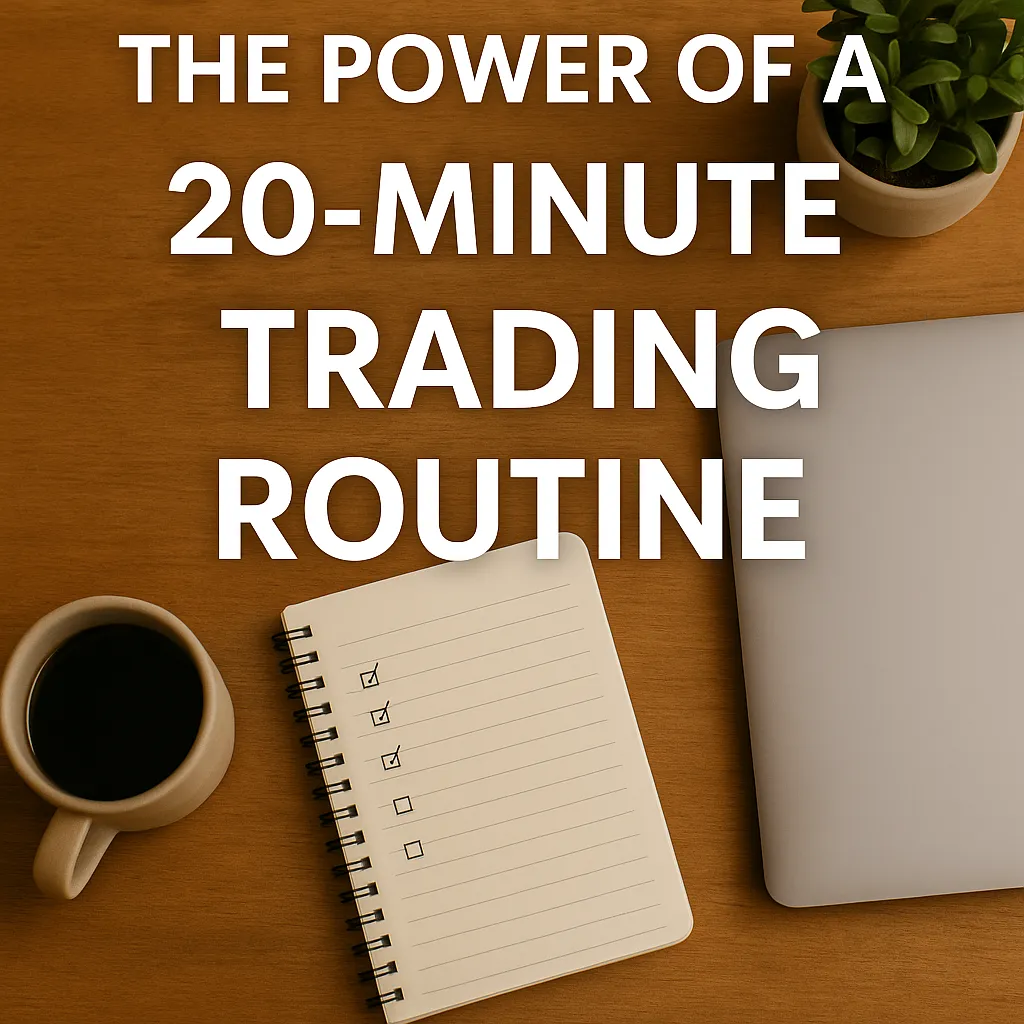
The Power of a 20-Minute Trading Habit
Let’s get honest about a problem that no one in the trading world likes to admit. Most people spend far too much time staring at screens, scrolling through stock charts, and bouncing between headlines. Yet they do not see better results for their effort. You might think that putting in more hours is the sure path to becoming a successful investor. You might believe that “hard work” in the form of watching every tick will make you more money or protect you from losses. I used to believe this too. But I learned the hard way that more is not better. Smarter is better.
If you are like most leaders I talk to, you do not have hours to burn every week watching stocks. You have a calling, a family, and a community depending on you. You need your investing to work for you, not the other way around. Today, I want to show you how a simple 20-minute habit can outperform weeks of busywork and help you build real consistency. This approach has helped me, and now it is helping dozens of leaders inside the Stocks for Pastors community.
I will break down the specific steps of this routine, show you why it works, and challenge the belief that more time is the answer. I promise you. If you commit to a focused process, even for just a few minutes each week, you can get the results you are after without trading away your time or peace of mind.
Why More Time Hurts Your Results
There is a myth out there that says successful traders are the ones who never step away from their screens. I get it. I bought into it myself early on. I thought that if I could just spend a few more hours analyzing charts, reading news, and jumping on every opportunity, I would be a better investor. The reality? I got burned out. My results did not improve. In fact, they got worse.
Why does this happen? The answer is simple. The more time you spend in front of your charts, the more likely you are to start making impulsive decisions. You second-guess your plan. You feel FOMO (fear of missing out) when you see a stock making a move and you are not in it. You start chasing trades, taking setups you would have skipped if you had just stuck to your process.
Even worse, this “screen addiction” has an emotional and spiritual cost. Fatigue sets in. You start to feel like you are falling behind, always one step away from the “big trade” that will change everything. Your family feels your distraction, and your ministry or business starts to suffer. You are working hard, but you are not working smart.
Here is the truth that took me years to admit. The secret is not in the hours, but in the discipline. A focused, repeatable process wins every time. You do not need to outwork everyone. You need to out-discipline them.
The Science of Short, Focused Habits
You might be skeptical. Can 20 minutes really make a difference? Behavioral science gives us a clear answer. Yes, it can. Habits that are short and focused are much more likely to stick and deliver long-term results. Why? Because they do not drain your willpower or burn you out. They keep you sharp, consistent, and less emotional.
Research in performance psychology shows that the quality of your routine matters far more than the quantity of time you put in. When your routine is simple, repeatable, and structured, you reduce the chance of emotional mistakes. You also make it easier to stay committed week after week.
I have seen this firsthand, not just in my own trading, but in the lives of my students. The leaders in our community who get the best results are not the ones who study the market for hours on end. They are the ones who pick a system, block out a small window of time, and show up with intention. They stick to the plan, week after week, month after month. Over time, this compounds into consistent, reliable results.
The 20-Minute Weekly Trading Routine
Let’s get into the nuts and bolts. Here is how you can get all your most important trading work done in just 20 minutes per week. I have broken it down into simple, actionable steps.
Watchlist Check (2 minutes)
Each day, or a couple of times per week if you prefer, take a quick scan of your watchlist. This list should already be filtered to include only stocks with strong seasonal patterns and high-quality setups. Look for any tickers that have triggered your buy or sell criteria. This is not about deep analysis. It is about noting potential opportunities. If nothing triggers, move on. The discipline here is to trust your process and not force trades just to be active.
Research and Confirm (2 minutes)
Once you see a possible setup, spend a few focused minutes reviewing the key data. Double-check the seasonality stats. Is this stock entering its historically strong period? Are there technical patterns, like a breakout or reversal, that confirm your idea? Check for major news or earnings events that could affect your plan. The goal is not to overanalyze but to confirm that your setup meets your criteria.
Plan and Place Trades (2 minutes)
With your setup confirmed, it is time to define your entry and exit. Write down your entry price, stop loss, and target based on the system you use. Decide how much of your portfolio you will allocate, staying within your risk limits. Then place your trade using a limit order or set an alert if the price is not there yet. Do not skip this step. Having a written plan protects you from making emotional decisions later.
Review and Log (1 minute)
After you place your trade, take one minute to log it in your tracking sheet or journal. Record the ticker, entry, stop, target, and the reason for the trade. This habit builds discipline, helps you track your progress, and allows you to learn from your wins and losses over time.
This whole process should take around 7 minutes once you build the routine and learn what to look for. Then all you need to do is repeat it 2 or 3 times per week. That's it! No sitting in front of monitors all day reading charts. No obsessing over each tick of price movement, or every dollar change in your open P/L. Just a smooth, efficient system for maintaining your investments that takes 14-21 minutes of your week to execute.
Why This Works for Busy Leaders
If you have ever felt like you do not have enough time or energy for trading, this habit is for you. Here is why it works so well.
Efficiency: You invest without stealing time from your family, ministry, or business. Your trades get done, and then you get back to your real priorities.
Discipline: Limiting yourself to 20 minutes a week keeps you from chasing every stock or reacting to every headline. It forces you to focus on your highest probability setups.
Accessibility: This system works even if you have limited experience or a small account. It is not about having the fanciest tools or the deepest pockets. It is about doing the right work, consistently.
In my community, I have seen busy leaders go from scattered and overwhelmed to calm and confident just by sticking to this 20-minute habit. They are seeing steady growth, less stress, and more margin in their lives.
Myths vs. Facts
Let’s break down some of the most common myths I hear from traders and investors and the facts that will set you free.
Myth: Serious traders work all day.
Fact: The best traders work a plan, then walk away. More time at the screen usually means more mistakes, not more money.
Myth: You need to watch every tick.
Fact: Most important decisions in trading are made once per week. The market will always give you another opportunity. The trader who checks in, executes, and gets on with life is the one who wins.
Myth: If you miss a trade, you have missed your chance.
Fact: There is always another setup. Obsessing over every missed opportunity is a recipe for burnout.
Myth: More trades mean more profit.
Fact: More trades usually mean more losses. The disciplined trader focuses on quality, not quantity.
Challenge and Next Steps
I want to challenge you. If you have been feeling overwhelmed, burned out, or stuck in analysis paralysis, try this 20-minute habit for the next two weeks. Block out two or three 7 minute times each week and follow the routine:
Watchlist check
Quick research
Plan and place your trades
Log everything
Track your results. Pay attention to how you feel. Less stressed, more confident, and more present for the people and work that really matter.
If you want a simple worksheet or checklist to help, reach out and I will send you my template. And if you are ready to level up, join our Growth Plan community, where I give you my pre-built monthly watchlist, step-by-step video lessons, and the support to make this habit stick.
You do not have to trade your life for trading success. You can build real wealth, one simple, focused habit at a time.
Let’s make the next two weeks the start of a new chapter. One where your trading fits your life, not the other way around.
Ready to get started? Share your thoughts below or send me a message and I’ll help you set up your 20-minute trading routine. Let’s build peace and margin, together.



